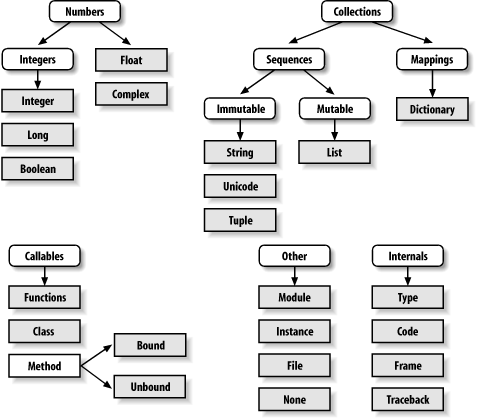| [ Team LiB ] |
|
7.7 Python's Type HierarchiesFigure 7-3 summarizes all the built-in object types available in Python and their relationships. We've looked at the most prominent of these; most other kinds of objects in Figure 7-3 either correspond to program units (e.g., functions and modules), or exposed interpreter internals (e.g., stack frames and compiled code). Figure 7-3. Built-in type hierarchies The main point to notice here is that everything is an object type in a Python system and may be processed by your Python programs. For instance, you can pass a class to a function, assign it to a variable, stuff it in a list or dictionary, and so on. Even types are an object type in Python: a call to the built-in function type(X) returns the type object of object X. Type objects can be used for manual type comparisons in Python if statements. However, for reasons to be explained in Part IV, manual type testing is usually not the right thing to do in Python. A note on type names: as of Python 2.2, each core type has a new built-in name added to support type subclassing: dict, list, str, tuple, int, long, float, complex, unicode, type, and file (file is a synonym for open). Calls to these names are really object constructor calls, not simply conversion functions. The types module provides additional type names (now largely synonyms for the built-in type names), and it is possible to do type tests with the isinstance function. For example, in Version 2.2, all of the following type tests are true: isinstance([1],list) type([1])==list type([1])==type([ ]) type([1])==types.ListType Because types can be subclassed in 2.2, the isinstance technique is generally recommended. See Chapter 23 for more on subclassing built-in types in 2.2 and later. |
| [ Team LiB ] |
|